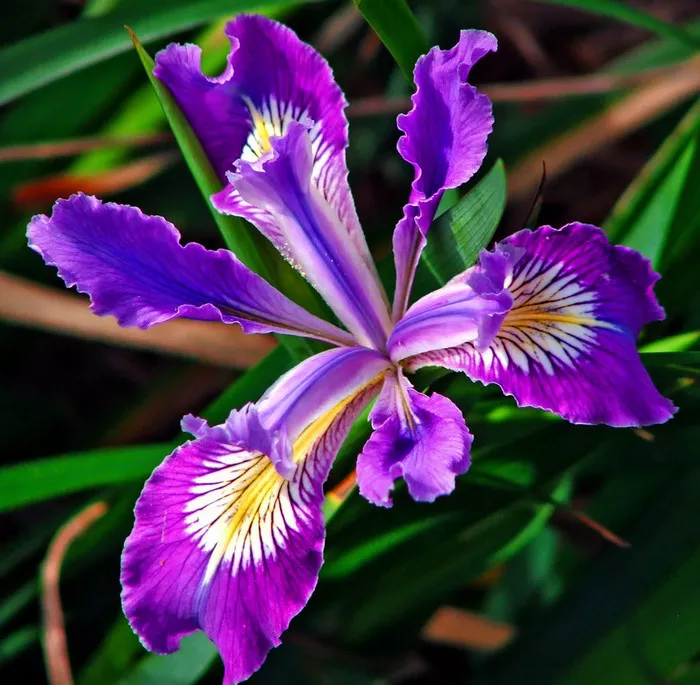The iris, a genus of flowering plants with over 200 species, has captured the fascination of botanists and horticulturists alike. Named after the Greek goddess Iris, the messenger of the gods and the personification of the rainbow, these flowers boast an array of colors and patterns that seem to mimic the vibrant hues of the mythical rainbow. The most common varieties include bearded irises, Siberian irises, and Dutch irises, each with its own unique characteristics.
Historical Roots: Iris in Ancient Civilizations
To truly understand the significance of the iris, we must embark on a journey through time, tracing its roots to ancient civilizations. The iris finds mention in Greek mythology, where it was believed to symbolize communication between mortals and the divine. The Greeks often associated the flower with Iris, the messenger goddess who bridged the gap between gods and humanity.
Moving eastward, the iris takes on a different role in Egyptian culture. Here, it was linked to the afterlife and used in burial rituals to guide departed souls. The striking appearance of the flower, with its three upright petals resembling an erect sword, contributed to its association with protection and transition to the next realm.
Iris in Art and Literature: A Symbolic Muse
As civilizations evolved, so did the role of the iris in artistic and literary expression. Renowned painters such as Vincent van Gogh and Claude Monet immortalized irises on canvas, capturing the intricate details and vibrant colors that have made these flowers timeless muses for artists.
In literature, the iris often serves as a symbol of inspiration and creativity. Poets and writers throughout history have woven the iris into their works, using its beauty as a metaphor for the depth and richness of human experience. The iris’s inclusion in these artistic endeavors further solidifies its place as a symbol that transcends mere botanical significance.
Cultural Variations: Iris Symbolism Around the World
As with many symbols, the meaning of the iris varies across cultures. In Japan, for instance, the iris is associated with protection and good health. It is often planted near homes to ward off evil spirits and is a popular motif in traditional art, showcasing the flower’s cultural importance.
On the other side of the globe, in Europe, the iris is commonly linked to the French monarchy. The fleur-de-lis, a stylized iris, became an emblem of royalty and nobility, representing power, honor, and the divine right to rule. This association has left an indelible mark on European history and heraldry.
Iris Flowers in Victorian Language of Flowers
During the Victorian era, when expressing sentiments through flowers reached its zenith, the iris found its place in the intricate language of flowers. Each bloom was carefully chosen to convey specific emotions and messages. The iris, with its various colors and intricate patterns, was often associated with sentiments such as faith, wisdom, and friendship. Understanding this floral language allowed individuals to communicate subtly, making the exchange of flowers a sophisticated art form.
Modern Symbolism: Iris in Contemporary Culture
In contemporary society, the iris continues to be a symbol of profound meaning. Its presence in gardens, floral arrangements, and weddings reflects a timeless appreciation for its aesthetic appeal and rich symbolism. Beyond its historical and cultural significance, the iris has found a place in modern spirituality and self-expression.
The LGBTQ+ community, for instance, has adopted the rainbow iris as a symbol of inclusivity and diversity. The various colors of the iris petals represent the spectrum of identities within the community, fostering a sense of unity and acceptance.
Iris in Mythology and Religion: A Comparative Analysis
To truly grasp the depth of iris symbolism, it is essential to explore its presence in various mythologies and religions. A comparative analysis reveals intriguing parallels and divergences in the interpretation of the iris across different belief systems.
In Greek mythology, the iris is a divine messenger, a link between the human and divine realms. This concept shares similarities with the role of angels in Christianity, acting as messengers of God. The iris’s association with communication and transcendence resonates across these diverse mythological landscapes, highlighting the universal themes that connect humanity’s spiritual narratives.
The Healing Power of Iris: Medicinal and Aromatherapy Applications
Beyond its symbolic significance, the iris boasts practical uses in traditional medicine and aromatherapy. Ancient cultures recognized the therapeutic properties of iris root, utilizing it for its anti-inflammatory and diuretic qualities. The distinctive fragrance of some iris varieties also contributes to their role in aromatherapy, where they are believed to promote relaxation and emotional balance.
Cultivating Iris: Tips for Growing and Caring
For those enchanted by the allure of irises, cultivating these flowers can be a rewarding endeavor. Whether you are a seasoned gardener or a novice with a green thumb, understanding the specific needs of iris plants is crucial for their successful growth. From choosing the right soil conditions to providing adequate sunlight and water, this section offers practical tips to ensure your iris garden flourishes.
Conclusion
In conclusion, the iris is more than a mere botanical wonder; it is a symbol that transcends time, culture, and individual experiences. From its mythical origins to its contemporary significance, the iris weaves a tapestry of meanings that enrich our understanding of the natural world and our place within it. Whether adorning a canvas, adorning a garden, or being exchanged as a token of affection, the iris continues to speak to the human soul, inviting us to explore the beauty and complexity of its language. As we unlock the secrets held within the petals of these enchanting flowers, we discover a profound connection between nature, art, and the shared narratives that define our collective human experience.


